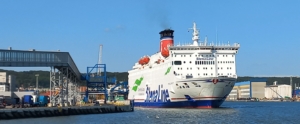Ports in the green corridor. Necessity or element of competition?

 By Marek Grzybowski
By Marek Grzybowski
The ports of Los Angeles, Long Beach and Shanghai unveiled plans to implement the first green transportation corridor across the Pacific in September this year. Representatives of cities and ports as well as the largest liner operators in the world, with the participation of leading cargo operators, developed a concept of a green shipping corridor implementation plan.
– The idea is to accelerate the reduction of harmful substance emissions on one of the busiest container transport routes in the world – emphasize the initiators of the project.
“This Trans-Pacific Green Corridor will be a model for the global collaboration needed to accelerate change across the maritime industry,” said Gene Seroka, executive director of the Port of Los Angeles.
CO2 reduction in the Pacific
– Reducing emissions in this corridor will bring significant reductions. For perspective, most of the emissions associated with shipping cargo occur on the mid-ocean portion of the journey between ports. This corridor will help reduce mid-ocean emissions while continuing the work we have done to reduce emissions in our ports, says Seroka.
The conceptual work was supported by C40 Cities experts. It is a global network of city mayors who inspire the urgent action needed to fight the effects of the climate crisis. In fact, the C40 initiative currently brings together about 100 cities. The Polish partners of this project include Warsaw, but there is no port city.
The C40 initiative acts as a coordinator of initiatives related to the creation of Green Shipping Corridors. The organization provides support to cities, ports and their partners in creating and developing the corridor by coordinating, convening, facilitating and providing communication support to advance the corridor’s objectives.
C40 Cities supports ports and shipowners
Mark Watts, executive director of C40, said: “C40 is proud to support this first-of-its-kind green shipping corridor, which aims to demonstrate that large-scale zero carbon shipping is feasible by 2030 and that less polluting ships and ports also mean cleaner air, less noise and more jobs for local communities.
With the connection provided by the major operators’ liner services between Los Angeles, Long Beach and Shanghai, the Ocean Green Corridor partners have set goals to begin introducing reduced or zero carbon emission ships on the connections by 2025.
– The creation of the first ever ecological shipping corridor across the Pacific has already taken clear shape – say representatives of the initiative.
The project involved the port authorities of Los Angeles, Long Beach and Shanghai, several of the world’s largest carriers and key leading cargo owners. They presented a program for implementing an ecological shipping corridor. They justify this by the need to accelerate emissions reductions on one of the world’s busiest container transport routes across the Pacific.
Zero-emission container ships by 2030
The idea is to demonstrate the feasibility of operating container ships with zero carbon dioxide emissions by 2030. The main initiators of the creation of the corridor include Shanghai International Port (Group) Co., Ltd., the China Classification Society, and the Maritime Technology Cooperation Center of Asia. The ports’ partners are line carriers: CMA CGM, COSCO Shipping Lines Co., Ltd., Maersk and ONE.
“This initiative will reduce emissions in the world’s largest ocean and lead to greener practices among supply chain participants along these key trade routes,” said Mario Cordero, CEO of the Port of Long Beach.
He said: “New and innovative ship technologies, increased availability of sustainable fuels and better practices created by the Green Corridor will also have an impact on society’s transition to a cleaner future far beyond the areas served by our ports.”
Green Shipping Corridor Partnership participants will take steps to reduce greenhouse gas emissions and emissions of harmful pollutants that impact air quality through methods such as expanding the use of land-based energy and supporting the development of clean ship refueling infrastructure.
Cargo ownership partners have set targets for contracting with carriers to use lifecycle zero carbon shipping services, and to measure progress towards decarbonization, all partners will develop metrics to track decarbonization progress.
Green corridors in Europe and Asia
In Europe and Asia, several ports and port cities as well as leading line operators and cargo operators already operate in green corridors. Creating green corridors on ocean connections and short sea shipping aims to reduce the harmful impact of maritime transport on the environment. Over 20 years ago, the transfer of cargo to short sea and inland navigation was actively promoted.
These other activities contribute to reducing the negative impact on the environment. But there is another aspect to these activities. Participation in green corridors may be an important tender element in building the competitive advantage of ports. In times of recession, shipowners can use this advantage to demand additional fees or postpone connections, or even exclude ports from services. Therefore, it is necessary to closely monitor market changes and participate in initiatives that may result in increased competitiveness on the global map of maritime transport. And this must be done when building new terminals or modernizing existing terminals.
